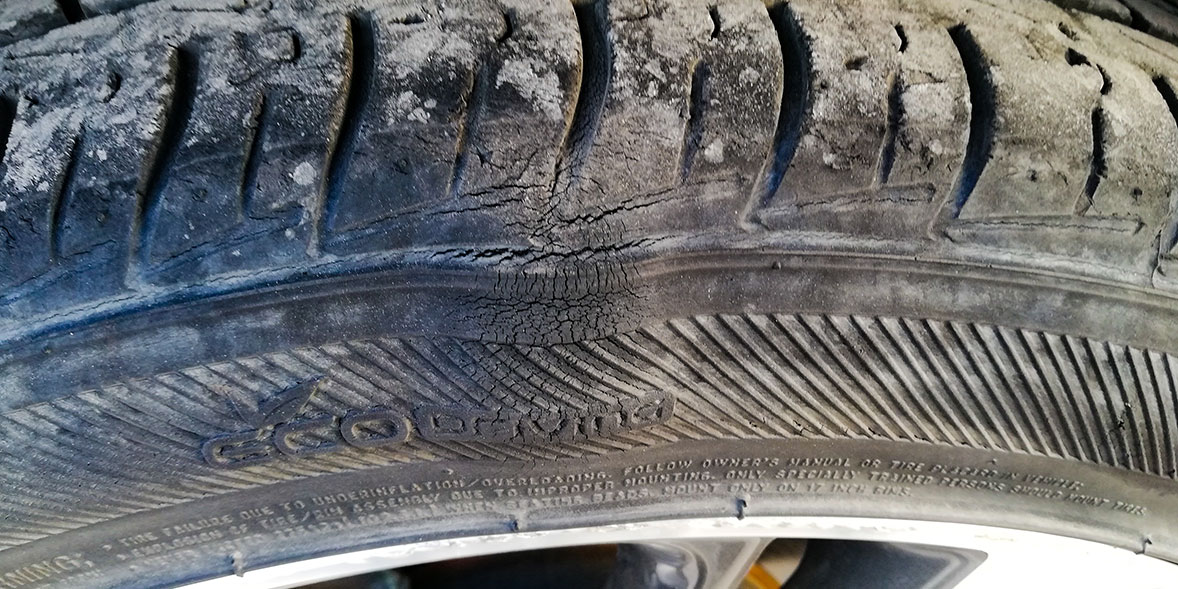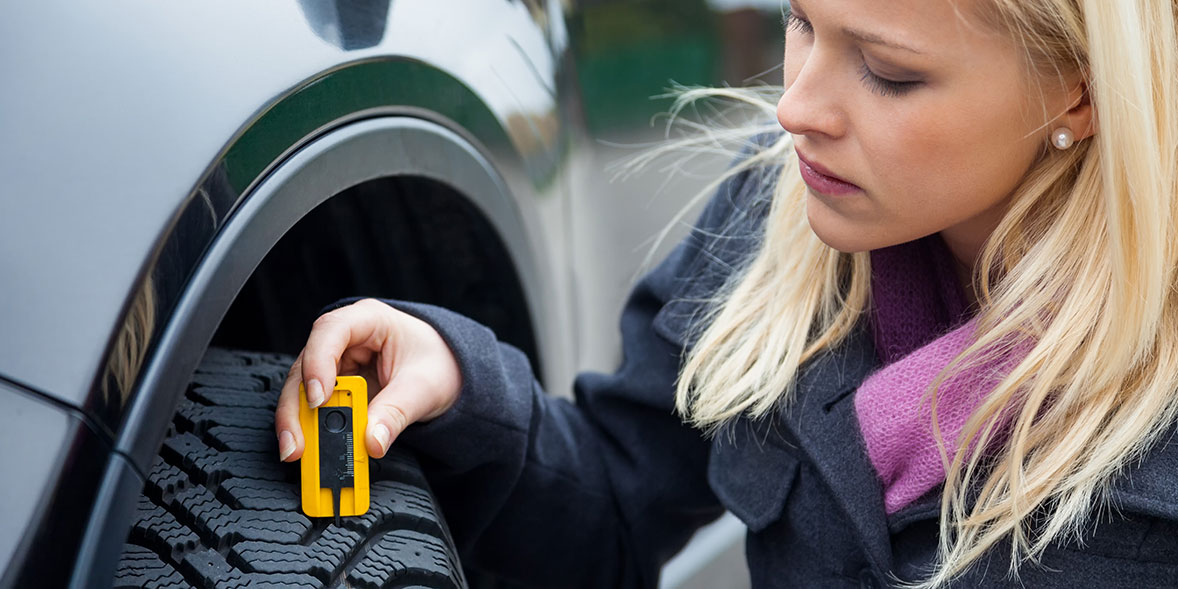How to change a car tyre or use a repair kit

Nobody expects to get a puncture when they head out in the car, but it’s better to know what you need to do before you get a flat rather than learning on the job at the side of the road.
In this guide, we'll take you through what you need to know about keeping your tyres healthy – and what to do when things go wrong.
Is a flat tyre the last straw for your current car? If you're considering replacing it, read our guide on where to buy a car.

What to do if you have a puncture
If you damage a tyre by striking an obstacle or particularly nasty pothole, it may deflate quickly. You’ll likely feel a tug on the steering wheel and will probably hear it as well – a bang or thud followed by a repeating ‘thwump-thwump’ sound.
If the tyre is deflating slowly, for instance after driving over a nail, the steering may just feel heavier than usual, or drag to one side.
Either way, you’ll need to pull over and stop as soon as possible. Do so somewhere safe if you can, such as a lay-by or side street. Try to avoid stopping on a busy, fast or poorly sighted road.
If you’re on a motorway, pull as far over to the left of the hard shoulder as you can, to maximise the distance between you and moving traffic, while still giving yourself room to access the flat tyre.
Turn off your engine, put on your hazard lights, engage the handbrake and put the car into neutral (or 'park' if you drive an automatic). Make sure everyone is out of the car and safely away from the road, and place a warning triangle on the road behind the car if you have one.
What you do next will depend on whether your car has a spare tyre, or, as many modern cars do, a tyre repair kit. It will also depend on how badly the tyre is damaged: repair kits only work with small holes, so if you can see a visible slash in the tyre and don't have a spare, you should call a breakdown service.
Puncture checklist: what to keep in your car
Check your boot now – and keep these crucial items handy so you don't get caught short:
- Spare wheel or space saver wheel
- Car manual: this will show where the jacking points are, as well as other information unique to your vehicle
- A wrench or torque wrench: whichever you use, make sure they fit your wheel nuts
- Locking wheel nut key: if you have alloys, one nut on each wheel will need to be removed using this key
- A warning triangle: while not a legal requirement, putting a reflective triangle behind your car will help alert drivers to your presence, especially on fast roads
- A hi-vis jacket: again, staying visible when you're changing a wheel is paramount for safety, especially in the dark and if you're changing a wheel on the side of the car that's closest to the road
- A jack and axle stand: many cars come with their own jack, specifically designed for use with that vehicle. An axle stand is an extra safety measure in case the jack fails
- Wheel chocks: an extra safety measure to stop your car rolling away; some cars come with these in the boot already.
If this isn’t the first time you've been left stranded, you’ll appreciate the benefit of good breakdown cover. Discover which providers we recommend, in our guide to the best car breakdown providers.
How to fit a spare wheel
Not all new cars come with a spare wheel. To save weight and cost, manufacturers now often supply a tyre sealant kit. If this applies to you, scroll down to read our step-by-step instructions to using a tyre repair kit.
- First, get out your spare wheel and tools, including the jack. They'll normally be found in the boot of the car, under the boot floor. Then grab your instruction manual, and thumb through it to locate the car's jacking point. The manual may also have instructions on how to change a tyre.
- You’ll also need the adapter for removing your car’s locking wheel nuts. This is normally located with the jack (unless you've moved it somewhere else for 'safe keeping'). Refer to the instruction manual if not.
- Double-check that your handbrake is fully engaged. Then, place the jack under the jacking point closest to the wheel you're going to change. Rotate the handle clockwise to raise the car. Ensure the jack is resting properly on the ground, as it takes the weight of the car.
- Once the tyre you're changing has cleared the ground, remove any trim that covers the wheel nuts. Then use the wrench provided, and the locking wheel nut adapter, to remove the nuts themselves.
- With the fixings removed, you should now be able to remove the wheel with the puncture and replace it with your spare. Be careful – a car wheel is normally quite heavy.
- Reattach the wheel nuts, then lower the car to the ground. Once the car is lowered, tighten up the nuts, ideally working in a diagonal pattern. So, if your car has five nuts arranged in a star shape (which is quite common), tighten the first one, then move to the third, fifth, second and, finally, the fourth.
How long can I drive on a spare wheel?
Spare wheels supplied with cars are typically ‘space savers’ – narrower than normal and with a lower speed rating, which will normally be marked on the wheel rim (typically 50mph). The tyres on these wheels are designed for emergency use only and won’t provide the braking or grip you get with a normal tyre.
It's best to get the faulty tyre replaced and a full-size new one put back on your car as soon as possible. Even if your car has a full-size spare wheel, we'd recommend visiting the garage anyway and getting the bolts retightened to the manufacturer’s recommended torque settings.

How to use a car tyre repair kit
Many cars are now sold without a spare wheel and are instead supplied with an emergency tyre repair kit. These typically consist of:
- Car tyre sealant Usually this is pressurised liquid latex, which may come with a connector to fit it to the tyre valve.
- Car tyre pump A compressor, powered by the car’s 12V socket, which will slowly reinflate the tyre once the hole has been sealed.
Using a repair kit is fairly fuss-free, but, like a space-saver wheel, it's only a temporary measure. Go to a garage to get your tyre repaired or replaced as soon as possible.
If you don’t feel comfortable changing your spare wheel – particularly in a precarious situation like a motorway hard shoulder – tyre sealant kits and compressors are available cheaply, either online or from an automotive retailer. They are a useful, less labour-intensive backup, although we wouldn’t advise using tyre sealant on a punctured space saver tyre, however.
Nor should you use a tyre repair kit if your car is fitted with ‘run flat’ tyres. These feature strengthened sidewalls and are designed to be driven for limited distances at low speed, even when deflated. These can be identified by markings on the sidewall, though these can vary between manufacturers. If you're buying a used car that originally came with run-flats, check whether all four of the tyres are still run-flats or if they've been replaced by normal tyres.
Also available are self-sealing tyres, which are designed not to go flat even if with a puncture, meaning you can safely continue to drive without requiring a tyre change. These tyres have a sticky resin inside the tread, which is able to seal holes of around 5mm or less. While these tyres can still be driven safely, tyre manufacturers still advise that you get to a tyre repair shop as soon as you can to check the integrity of the tyre and have a patch added if required.
Step-by-step: how to repair a car tyre puncture

- Follow the same procedure for stopping safely as above. Grab your repair kit – it's usually found under the boot floor.
- Follow any provided instructions. In most cases, using it is simply a case of connecting the bottle of tyre sealant to the valve on the wheel rim. Most bottles are pressurised, so the latex will flow through the valve into the tyre.
- Once inside the tyre, the sealant should find and seal the hole. Now, connect the compressor to the 12V socket. Start the engine, then the compressor, and pump up the tyre to the recommended pressure.
- If the hole does not seal immediately, disconnect the compressor and try driving the car forwards or backwards a few metres to spread the sealant around the inside of the tyre. Then reattach the compressor and try again.
Top tip: tyre repair kits often have ‘best before’ dates, after which the sealant dries up and must be replaced.
A tyre repair kit will often get you out of immediate trouble, but is no good for holes larger than about 4mm. If you have a serious blowout or have damaged a tyre sidewall, you will have to call a breakdown service. Check out our guide on how to find good car breakdown cover.
How to check your car tyre pressure

Ensuring your tyres are at the recommended pressure is the easiest step you can take to maintain your tyres. It won’t prevent a puncture, but even if they’re only slightly underinflated, it can have a negative impact – not only on your fuel economy, but on your car’s braking performance too.
Over-inflating tyres can mean they wear unevenly and may become more susceptible to damage from striking kerbs or sharp stones.
How do I know the tyre pressure for my car?
Your car's handbook will tell you the correct tyre pressures, or you may find it printed on a sticker inside the driver or passenger door. This will often include information on tyre pressures to use depending on the load you’re carrying and for different wheel sizes.
Some modern cars have built-in automatic tyre pressure monitors, but we recommend regular manual checks as well.
Ways to check your tyre pressure
A hand-held tyre pressure gauge is an easy way to determine whether your tyres need inflating – they're available from a range of online and physical retailers and typically cost less than £20. Simply attach the tyre pressure gauge to the valve on the wheel rim (after removing the dust cap), press down evenly to ensure a tight seal and read the measurement.
Alternatively, the tyre pump on a petrol station forecourt will normally read the tyres' starting pressure before you begin inflating.
How often should I check my tyre pressure?
Ideally, you should check your tyre pressure every couple of weeks, particularly if you drive your car regularly. It's also sensible to check before you embark on any long journeys. Check when the tyres are 'cold' (so they haven't been driven on for a couple of hours). If you need to drive to a petrol station to check the tyre pressure, choose one that's as close to your starting point as possible.
How do I pump up my car tyres?
An automatic pump at a petrol station and garage is normally the easiest and quickest way of inflating tyres. They’re usually coin-operated and allow the user to set the maximum pressure via a digital display. Pay attention as to whether the readings are in BAR or PSI – the two different measurements used.
Simply attach the hose to your wheel and the pump will do the rest. Most will even deflate a tyre if it detects it’s at a higher pressure than the user has set.
Whichever method you use, it’s best to inflate a tyre when it’s cold. The pressure in tyres increases as they heat up, which could lead to a false reading.
Car tyre maintenance and safety tips
Check your car tyres regularly for excessive or uneven wear. Remove any stones or debris wedged in the tread, and keep an eye out for any deep cuts or bulges (see image below). Bulges can be signs of imminent tyre failure and the tyre should be inspected and replaced as soon as possible.
If you hit a kerb or bad pothole, you should make sure you haven't damaged a wheel. If the rim is scuffed, has it caused any sharp or rough edges? Any damage close to the tyre’s sidewall should be repaired quickly, and you should ask a garage to rebalance the wheel afterwards.

Monitor tyre tread depth
By law, your car tyres must have a minimum tread depth of 1.6mm in a continuous band across three quarters of the width of the tyre.
However, tyre performance deteriorates well before the legal minimum depth is reached, particularly in wet weather. This is because the volume of the tread grooves is reduced, so they are less effective at dispersing surface water from the road.
Don't wait for the MOT test to find out if your tyres are up to scratch. Check your tyres regularly and consider buying new ones before they reach the legal minimum.

Look after your spare tyre
The only thing worse than getting a puncture is when you go to fit the spare and discover that it has also gone flat. Check the spare regularly for pressure and condition, because if your spare is old, the rubber may begin to perish, resulting in potentially dangerous cracks in the tread or sidewalls. This is particularly relevant if your spare wheel is stored on the outside of your vehicle, as is the case with some large SUV models.
Drive smarter and cut costs using our expert advice. Get our Cars newsletter – it's free monthly
Compare car insurance
Find the right policy for your vehicle using the service provided by Confused.com
Get a quote now